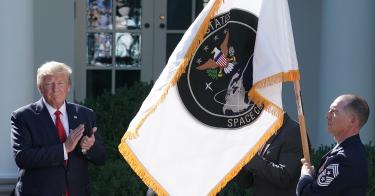On Aug. 29 the Defense Department formally established the U.S. Space Command. The military’s 11th unified combatant command, it now takes its place alongside commands like Special Operations Command and Central Command.
Many Americans may not see this as a big deal. But those who understand how America conducts military operations see it as a very big deal, indeed.
That’s because the four military services — Army, Air Force, Marines and Navy — don’t command forces in wartime.Since World War II the United States has almost always placed combat forces under the operational control of a unified commander.Remember how Dwight Eisenhower was the supreme commander of all Allied forces in the European theater in World War II? That is an example of unified command.
Today, the 11 combatant commanders provide unified command for U.S. joint forces. Combatant commanders, always a 4-star general or admiral, plan and conduct unified actions in accordance with the guidance from the president and the secretary of defense.
Combatant commanders enjoy broad responsibility and authority.They answer only to the secretary of defense and have unquestioned authority over all assigned forces.The combatant commander’s opinions are given great weight when matters of resources or priorities are debated in the Pentagon.
Before Space Command was created, U.S. Strategic Command (STRATCOM), headquartered in Offutt Air Force Base in Nebraska was responsible for space operations.But STRATCOM had many other responsibilities, foremost among them being the maintenance of America’s nuclear deterrent. So space had to compete for attention and resources within STRATCOM.
That worked for a while. Until it no longer did.
Over the years, U.S. forces have increasingly come to rely on space-based assets.Spy satellites provide critical intelligence; global positioning satellites provide accurate navigation needed for precision-guided munitions;and communications satellites provide anywhere communications for globally distributed forces. These capabilities have come to define how U.S. forces fight, and many of our military advantages hinge on them. Protecting our space assets to ensure uninterrupted access is now essential for our nation’s success.
Russia and China have closely observed our growing dependence on these assets and have developed their own significant military capabilities that can challenge the United States in space. China has tested an anti-satellite weapon and continues to explore similar methods. Indeed, space must now be considered a full war-fighting domain.
Growing unease about this development led Congress to order a bipartisan study on the subject.In August 2018 the group released its findings: the “Final Report on Organizational and Management Structure for the National Security Space Components of the Department of Defense.”
One of its key recommendations was to establish a combatant command for space.
Heeding that recommendation, President Donald Trump last December signed a Presidential Space Memorandum directing the establishment of the U.S. Space Command. In the words of Gen. John Hyten, commander of U.S. Strategic Command, “We have to have a commander focused on it all the time from an operational perspective … somebody in the Pentagon that focuses their total attention on space all the time.”
Just as Central Command handles military operations in the Middle East, Space Command will be charged with those same responsibilities in the domain of space.
When Air Force General Jay Raymond accepted command of Space Command he inherited 87 units that cover the gamut from missile warning, to satellite operations, space control, and space support. His job will be to organize, unify and then focus that team on the new challenge: waging and winning a war in space.
With the creation of Space Command, America now has an empowered commander and command able to make the necessary choices and advocate for the resources needed to ensure we always have access to the assets we need in space. It’s a wise move.
This piece originally appeared in The Detroit News



